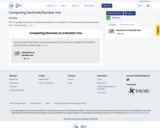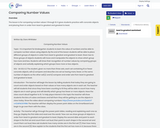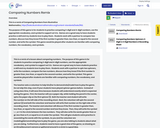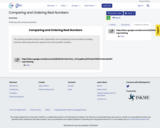
This is a google slides lesson comparing decimals on a number line. Students first locate the decimals, then compare using <, >, or =.
- Subject:
- Mathematics
- Material Type:
- Activity/Lab
- Author:
- Elsie Owens
- Date Added:
- 05/18/2021

This is a google slides lesson comparing decimals on a number line. Students first locate the decimals, then compare using <, >, or =.

Students create different versions of a known song and listen to contrasting recordings for musical differences and similarities.

This is a Jamboard to compare fractions. The students will drag <, >, or = to make each statement true.

Jamboard comparing fractions, decimals, and percents. Students will click on sticky notes and drag to boxes. These will be put in order from least to greatest.

This Desmos activity has students partiiton a fraction into fourths, model a fraction, and then determine if the fraction is more than, less than, or equal to 1/2 by looking at the denominator.

Fun Social Studies review to compare/contrast Ancient Greece and Rome

Students will examine a map projection of a chosen USGS topographic map versus other maps. The teacher will explain that each map is drawn according to a specific map projection. Students will be given or shown a USGS poster of numerous map projections, as well as cartography in texts to illustrate how distance, direction, angle, or area have to be distorted.

Students will examine a map projection of a chosen USGS topographic map versus other maps. The teacher will explain that each map is drawn according to a specific map projection. Students will be given or shown a USGS poster of numerous map projections, as well as cartography in texts to illustrate how distance, direction, angle, or area have to be distorted.

The lesson is for comparing number values 1 through 10. It gives students practice with concrete objects and placing them in order from least to greatest and greatest to least.

You can play this game to practice 3.1c Comparing Numbers in a fun and interactive format. Students can battle each other to see who can answer the questions the quickest. Boys can play against girls or any groups can be made.

This is a remix of Comparing Numbers from Illustrative Mathematics, https://tasks.illustrativemathematics.org/content-standards/tasks/1102.The purpose of this game is for students to practice comparing 3-digit and 4-digit numbers, use the appropriate vocabulary, and symbol to support sol 3.1c. Games are a great way to have students practice a skill and my students love to play them. Students work with a partner to compare two numbers, discuss how they know if the first number is greater than, less than, or equal to the second number, and write the symbol. This game would be played after students are familiar with comparing numbers, the vocabulary, and symbols.

Students compare slope as it relates to distance vs. time. Using a simulation on Desmos, students find that faster speeds create steeper slopes on a graph.

This is a remix of "Comparing Speeds in Graphs and Equations" by Illustrative Mathematics. The activity can be used to introduce the characteristics of direct variations. There is also a link to a direct and inverse variation foldable.

Within this interactive lesson, students will navigate and explore comparing positive and negative fractions, deicmals, and percents through Desmos. Students will also gain practice from finding equivalencies, using picture representations and number lines, and through mathematical discourse. Students will be able to do the following:Use a number line to sort, compare, and order integers, fractions, decimals, and percents.Compare integers, fractions, decimals, and percents.Order integers, fractions, decimals, and percents.

Within this interactive lesson, students will navigate and explore comparing positive and negative fractions, deicmals, and percents through Desmos. Students will also gain practice from finding equivalencies, using picture representations and number lines, and through mathematical discourse. Students will be able to do the following:Use a number line to sort, compare, and order integers, fractions, decimals, and percents.Compare integers, fractions, decimals, and percents.Order integers, fractions, decimals, and percents.

Within this interactive lesson, students will navigate and explore comparing positive and negative fractions, deicmals, and percents through Desmos. Students will also gain practice from finding equivalencies, using picture representations and number lines, and through mathematical discourse. Students will be able to do the following:Use a number line to sort, compare, and order integers, fractions, decimals, and percents.Compare integers, fractions, decimals, and percents.Order integers, fractions, decimals, and percents.

Students will create their own sets of numbers to order in this whole group activity.

Teachers will give out cards to students and have them practice comparing and ordering real numbers.

Ordering real numbers practice

Introduction:The atmosphere consists of many different layers that each have unique characteristics. Other things in day to day life also consist of layers that have unique characteristics, like beds, burritos, and sandwiches. Task: Draw a picture to compare the layers of Earth’s atmosphere to something else that has layers. For example, you could draw a cheeseburger and write “The lettuce on the cheeseburger is like the Mesosphere, because they are both the coldest layers.”